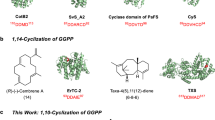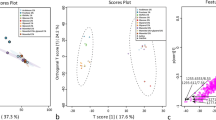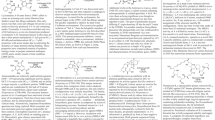Abstract
Four new α-pyrone derivatives, named germicidins P-S (1-4) along with nine known analogues (5-13) were discovered from the sponge-associated Streptomyces sp. 18A01 guided by Global Natural Products Social (GNPS) molecular networking, the LC-DAD-MS profile, and hexokinase II (HK2) inhibitory activity. The structures of 1-13 were elucidated by analysis of their HRMS, optical rotation, and NMR spectroscopic data. The absolute configurations of germicidin P (1) and germicidin Q (2) were determined on the basis of comparisons of experimental and theoretically calculated ECD spectra. Bioactivities of the isolated compounds were assayed against human HK2. The bioassay results showed that compounds 1-4 and 11-13 exhibited significant inhibitory activities against HK2, with IC50 values ranging from 5.1 to 11.0 μM. A molecular docking simulation demonstrated that these germicidins were docked in the inner active site tunnel of HK2. Interestingly, the amino residue Arg91 has a better binding affinity and efficacy than the amino residue Asn89 in the process of HK2 binding to the ligands, resulting in better hexokinase inhibitory activity. This result provided a valuable perspective for better understanding their HK2 inhibition activity.
This is a preview of subscription content, access via your institution
Access options
Subscribe to this journal
Receive 12 print issues and online access
$259.00 per year
only $21.58 per issue
Buy this article
- Purchase on Springer Link
- Instant access to full article PDF
Prices may be subject to local taxes which are calculated during checkout






Similar content being viewed by others
References
Pan HQ, et al. Streptomyces bohaiensis sp. nov., a novel actinomycete isolated from Scomberomorus niphonius in the Bohai Sea. J Antibiot. 2015;68:246–52.
Marchbank DH, Ptycia-Lamky VC, Decken A, Haltli BA, Kerr RG, Guanahanolide A. A meroterpenoid with a sesterterpene skeleton from coral-derived streptomyces sp. Org Lett. 2020;22:6399–403.
Jiao WH, et al. Anti-MRSA actinomycins D1-D4 from the marine sponge-associated Streptomyces sp. LHW52447. Tetrahedron. 2018;74:5914–9.
Yang MX. et al. Antagonistic activity of marine Streptomyces sp. S073 on pathogenic Vibrio parahaemolyticus. Fish Sci. 2019;85:533–43.
Wang JX, et al. Dimeric tetrahydroanthracene regioisomers and their monomeric precursor produced by Streptomyces fumigatiscleroticus HDN10255. J Nat Prod. 2020;83:2797–802.
Wang C, Mei XG, Zhu WM. New natural products from the marine-derived Streptomyces Actinobacteria. Stud Mar Sin. 2016;51:86–124.
Ramesh S, Mathivanan N. Screening of marine actinomycetes isolated from the Bay of Bengal, India for antimicrobial activity and industrial enzymes. World J Microbiol Biotechnol. 2009;25:2103–11.
Lam KS. Discovery of novel metabolites from marine actinomycetes. Curr Opin Microbiol. 2006;9:245–51.
Rahman H, et al. Novel anti-infective compounds from marine bacteria. Mar Drugs. 2010;8:498–518.
Pimentel-Elardo SM, et al. Anti-parasitic compounds from Streptomyces sp. strains isolated from mediterranean sponges. Mar Drugs. 2010;8:373–80.
DeWaal D, et al. Hexokinase-2 depletion inhibits glycolysis and induces oxidative phosphorylation in hepatocellular carcinoma and sensitizes to metformin. Nat Commun 2018;9:446.
Bao FY, et al. New natural inhibitors of hexokinase 2 (HK2): Steroids from Ganoderma sinense. Fitoterapia .2018;125:123–9.
Patra KC, et al. Hexokinase 2 is required for tumor initiation and maintenance and its systemic deletion is therapeutic in mouse models of cancer. Cancer Cell. 2013;24:213–28.
Zhang XM, et al. Hexokinase II inhibitory effect of secondary metabolites derived from a Streptomyces sp. associated with mud dauber wasp. Chem Biodivers. 2020;17:e2000140.
Yang JY, et al. Molecular networking as a dereplication strategy. J Nat Prod. 2013;76:1686–99.
Crüsemann M, et al. Prioritizing natural product diversity in a collection of 146 bacterial strains based on growth and extraction protocols. J Nat Prod. 2017;80:588–97.
Kang KB, et al. Targeted isolation of neuroprotective dicoumaroyl neolignans and lignans from Sageretia theezans using in silico molecular network annotation propagation-based dereplication. J Nat Prod. 2018;81:1819–28.
Ding LJ, et al. Production of new antibacterial 4-hydroxy-α-pyrones by a marine fungus Aspergillus niger cultivated in solid medium. Mar Drugs. 2019;17:344.
Wang C, Wang LP, Fan J, Sun KL, Zhu WM. Cytotoxic compounds from the deep-sea sediment-derived Streptomyces malaysiensis OUCMDZ-2167. Chin. J Org Chem. 2017;37:658–66.
Ma M, et al. Germicidins H–J from Streptomyces sp. CB00361. J Antibiot. 2017;70:200–3.
Wang YJ, et al. Isolation, identification and antimicrobial activity of secondary metabolites from a soil-derived Streptomyces sp. L8 of Qinghaihu. Nat Prod Res Dev. 2018;30:1170–5.
Douchi T, Akitake M, Sonoda M, Sugiyama Y, Tanimori S. Enantio and diastereoselective total synthesis of all four stereoisomers of germicidin N. Synth Commun. 2020;50:1504–11.
Li W, et al. Benserazide, a dopadecarboxylase inhibitor, suppresses tumor growth by targeting hexokinase 2. J Exp Clin Canc Res. 2017;36:58.
Pan HQ, Bai Y, Hu JC, Yao XC 2020; Patent no. 202011604925.9.
Wang MX, et al. Sharing and community curation of mass spectrometry data with Global Natural Products Social Molecular Networking. Nat Biotechnol. 2016;34:828–37.
Chambers MC, et al. A cross-platform toolkit for mass spectrometry and proteomics. Nat Biotechnol. 2012;30:918–20.
Shannon P, et al. Cytoscape: a software environment for integrated models of biomolecular interaction networks. Genome Res. 2003;13:2498–504.
Frisch MJ, et al. Gaussian 09, Revision A.1; Gaussian, Inc.: Wallingford, CT, 2009.
Autschbach J. Time-dependent density functional theory for calculating origin-independent optical rotation and rotatory strength tensors. Chem Phys Chem. 2011;12:3224–35.
Bruhn T, Schaumloffel A, Hemberger Y, Bringmann G. SpecDis: quantifying the comparison of calculated and experimental electronic circular dichroism spectra. Chirality. 2013;25:243–9.
Morris GM, et al. Automated docking using a Lamarckian genetic algorithm and an empirical binding free energy function. J Comput Chem. 1998;19:1639–62.
Huey R, Morris GM, Olson AJ, Goodsell DS. Software news and update a semiempirical free energy force field with charge-based desolvation. J Comput Chem. 2007;28:1145–52.
Acknowledgements
This work was funded by the Doctoral Start-up Foundation of Liaoning Province (2019-BS-258), the National Natural Science Foundation of China (31872036, 41776178, and 41576136), the Liaoning Revitalization Talents Program (XLYC1807268), the Open Subject of Guangdong key Laboratory of Marine Materia Medica (LMM2020-9), and the Youth Innovation Promotion Association CAS (2018229).
Author information
Authors and Affiliations
Contributions
YB conducted the experiments. PY performed the ECD calculations. YW performed the LC-MS/MS analysis. YZ and JJ collected the sponge and revised the manuscript. JH revised the manuscript. HP isolated strain 18A01 and designed the experiments. YB and HP analyzed the data and wrote the manuscript. All authors approved the manuscript.
Corresponding author
Ethics declarations
Conflict of interest
The authors declare no competing interests.
Additional information
Publisher’s note Springer Nature remains neutral with regard to jurisdictional claims in published maps and institutional affiliations.
Supplementary information
Rights and permissions
About this article
Cite this article
Bai, Y., Yi, P., Zhang, Y. et al. Structure-based molecular networking for the target discovery of novel germicidin derivatives from the sponge-associated streptomyces sp. 18A01. J Antibiot 74, 799–806 (2021). https://doi.org/10.1038/s41429-021-00447-w
Received:
Revised:
Accepted:
Published:
Issue Date:
DOI: https://doi.org/10.1038/s41429-021-00447-w
This article is cited by
-
Improved polyketide production in C. glutamicum by preventing propionate-induced growth inhibition
Nature Metabolism (2023)



